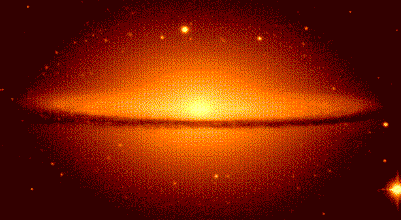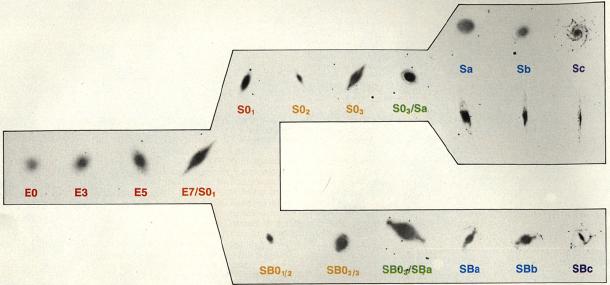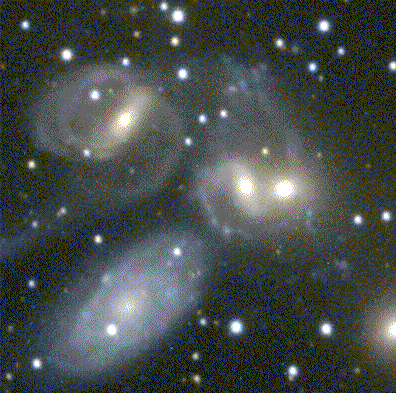 Galactic Dynamics --- | ---
Expansion of the Universe
Galactic Dynamics --- | ---
Expansion of the Universe

 Galactic Dynamics --- | ---
Expansion of the Universe
Galactic Dynamics --- | ---
Expansion of the Universe

 Reading:
Reading:
Chapter 21 (ZG4)
Notes:
pages 90-93
 |
Key Question: | What are the observed properties of galaxies? |
|---|---|---|
 |
Key Principle: | Galaxies are big and there are lots of them. |
 |
Key Problem: | Hey - just look at pretty pictures of galaxies. |
There are many more faint low-mass stars than there are bright high-mass stars. We can quantify this by counting the number of stars of a given mass or luminosity per cubic parsec of the galaxy. We can only do this easily in the neighborhood of the Sun, where we can be sure of seeing all the stars, and of getting good distances (and thus luminosities from brightness). The masses must be estimated from the H-R diagram unless in a binary. The resulting mass and luminosity counts are called the mass function and luminosity function respectively.
We will discuss the mass function, though what we say applies to the luminosity function, through the mass-luminosity relation. We consider only main sequence stars for now. We let N(M)dM represent the number of stars between mass M and M + dM per cubic parsec of space. The function N(M) is the mass function, in units of number of stars per Solar Mass per cubic parsec. If we factor out stellar evolution, and consider the initial mass function as the stars are formed, we find the relation:
The constant N_0 is the number of 1 Msun stars (around 4 per Msun per pc^3). This relation is known as the Salpeter initial mass function.
The Sun is a G2 dwarf star (main sequence stars are called "dwarfs" to distinguish them from giant stars of the same spectral type). There are about 4 Msun/pc^3 in G stars in the solar neighborhood. Likewise, there are around 25 Msun/pc^3 in M dwarf stars, which are much less massive than the Sun but much more numerous.
We have established that there must be siginificant amounts of dark matter in the halo of our galaxy. The overall mass-to-light ratio for our galaxy, which is dominated by the massive halo, is somewhere between 10 and 100 Msun/Lsun. What can this halo dark matter be made of?
Low luminosity stars - the main sequence mass-luminosity relation gives L proportional to M^3.5, so the mass-to-light ratio M/L is proportional to M^-2.5. Thus, main sequence stars less massive than the Sun will have a M/L > 1. It is likely that these make up the disk dark matter, which has M/L about 3 Msun/Lsun. However, you would need to have many more faint stars in the halo compared with bright stars than there is in the disk.
Brown Dwarfs - "failed" stars or large planets (Jupiters) are extreme examples of low luminosity stars. They can have very large M/L, though it would be hard to see how there are so many of them to contribute large amounts of total mass to the galaxy halo. This is a general problem with having lots of low-mass, high M/L objects make up the halo.
Compact Objects - non-main sequence stars such as white dwarfs, neutron stars, or black holes. These are high-mass, high M/L objects so you dont need quite so many of them. On the other hand it is still hard to see why there would be a lot of mass in post-main sequence objects. In general, most of the mass in a standard distribution of stars like those near the Sun have most of the mass in stars about the same mass of the Sun, or lower. Thus, you have the opposite problem as with low-mass stars, you need to have predominantly massive stars which then evolve rapidly off the main sequence to compact objects. This leads to the problem of making too many heavy elements in all those supernovae! Not a great solution.
Massive Particles - some strange new particle that interacts only weakly with matter, and not at all with light (except through gravity). Not disallowed by physics, but would be somewhat unexpected, but an exciting prospect for physicists. There have been many searches and theoretical papers on this, and still must be considered a leading possibility. As we see when we talk about dark matter in cosmology, this would have important implications for the fate of our Universe also.
We can break these possibilities into two classes: massive compact halo objects (MACHOS) like stars, brown dwarfs, planets, compact objects, etc., and weakly interacting massive particles (WIMPS). Particle physicists have taken the lead in searching for WIMPS, so far without success. Astronomers have been looking for MACHOS, using techniques such as gravitational microlensing, as described in the next section.
If one star passes in front of another, the bending of light by gravity will cause the foreground star to act as a gravitational lens magnifying the background star. Because the splitting of images of the background star by lensing from the foreground star is on the scale of micro-arcseconds and thus too small to be seen with telescopes, this is called microlensing.
If the lens is directly in front of the background star, then it is imaged into a ring of a radius proportional to the square-root of the mass of the lensing star. This is called an Einstein ring. If the foreground star is very close to, but not directly over, the background star, then you get two images of the star, which nevertheless increases the total brightness of the background star. The ring and the two image splitting, as mentioned before, are a few micro-arcseconds, and so not visible in telescopic images. In fact, you cannot separate out the foreground and background star images, you only see the sum of the two brightnesses, and the brightening cause by the lensing magnification.
Given a sample of background stars to look at, the statistics of microlensing tells you about the distribution of the foreground stars doing the lensing, their masses, and their velocities. In a microlensing event, the foreground star passes in front of the background star, which is seen to brighten then fade back to normal. The time it takes to brighten then fade depends on the distance and velocity of the lens in a straightforward manner:
The angle of the lensing (the bending) depends on the mass of the lens, thus microlensing magnification (the brightening) and the duration give us a handle on the mass, distance, and velocity of the lens in a complicated combination.
In the last few years there have been several observational programs to look for and measure the statistics of microlensing. One of these, called MACHO after the types of dark matter object they are looking for in the halo, looked at the Large Magellanic Cloud (LMC) which is a nearby (about 53 kpc away) small (about 10^7 stars) companion galaxy to our Milky Way. Since the LMC is out of the plane of our galaxy, this is a good probe of the halo dark (and light) matter in MACHOS. During the times of the year when the LMC was not up at night, MACHO looked at stars in our galactic bulge in a direction of low obscuration called Baade's Window.
The other groups looked at the galactic bulge only. The largest of these projects is called OGLE, or Optical Gravitational Lens Experiment. Both MACHO and OGLE monitor the brightness of 10^6 to 10^7 stars in the LMC or bulge every night! This is no mean feat, and is only possible through the use of automated telescopes, CCD cameras, and computer controlled automated analysis of the huge amounts of data. This has been possible only in the last few years.
Both MACHO and OGLE see dozens of events (more than 60 total) toward the galactic bulge. These are due to stars in the disk and bulge, and have shown the existence of a bar in the center of our galaxy - an elonated distribution of stars as seen in some other galaxies. This is an important find for the study of galactic structure, and was not know before (though some astronomers had postulated its existence). These microlensing events are consistent with being due to the known types of stars, and no strange dark matter is needed to explain this.
The MACHO project has seen around 7 events toward the LMC, at least one of which is due to a lens in the LMC itself. In a recent press release, they claim that their results could be due to as much as 50% of the halo dark matter being in MACHOs of masses from 0.1 to 1 Msun, and thus white dwarfs! Unfortunately, it is likely that they are being a little overambitious in their conclusions, and it is more likely that their results are consistent with what we know is out there in normal halo stars, plus more of the events due to LMC starst themselves. Their claimed dark matter would mean that there is an unexpectedly large number of post-main sequence stars in the halo, and thus there would be a huge amount of heavy elements locked up in them. With so few events, its hard to justify these strong conclusions, only more data over the next few years will tell us the real story. Don't take everything you read about science in the press at face value - look carefully at all the possibilites first!
We are not alone in the Universe, there are many other galaxies visible in the sky, and they come in a variety of shapes and sizes. Working from the Mount Wilson observatory in the years after World War I, he took many images of galaxies, and classified them by their appearance, or morphology. He put them into three main classes: spiral, elliptical, and irregular. This is the classification we use today, and like many empirical relations (eg. the H-R diagram) the Hubble sequence has profound implications for the formation process of galaxies.

This image was nabbed from George Lake.
Spiral galaxies are galaxies like our own Milky Way and M31 (the Andromeda galaxy). Spiral galaxies have prominent spiral arms (hence their names) and a well-defined galactic disk. They also, to varying degrees, have a galactic bulge. The spirals are sub-classes as a,b,c by how prominent the bulge is compared to the disk: Sa (large bulge, small disk), Sb (medium bulge, medium disk), and Sc (small bulge, large disk). M31 is an Sb galaxy.
There are two types of spirals: normal spirals S and barred spirals SB. Barred spirals have a prominent bar in the center, from the ends of which the spiral arms trail outward. Like the normal spirals, the barred spirals are sub-classified by the bulge/disk ratio: SBa, SBb, SBc. In light of the recent microlensing discoveries, the Milky Way is most likely a barred spiral galaxy of class SBb.
Elliptical galaxies have no disk, and they are like a giant galactic bulge and halo. They do have many globular clusters like the halo of our galaxy. They are almost entirely made of Pop II stars, and have little gas, and thus no ongoing star formation. Like our halo, there is little net rotation and the stars are on highly elliptical orbits. Elliptical galaxies are sub-classified by how "elliptical" in shape they are, ranging from E0 (round) to E7 (highly elongated). Although we see their dimensions only in projection on the sky, elliptical galaxies do seem to be prolate, that is football or cigar shaped (two short axes and one long one), rather than oblate, like a squashed sphere or saucer (two long axes and one short one), though there may be a whole range in the relative dimensions of the three axes (ie. triaxial).
There are lenticular galaxies, S0, which appear to be intermediate between spirals and ellipticals. They have a very large bulge and halo, and a very small disk with no trace of spiral arms.
The irregular galaxies, Irr, are those with amorphous shapes, like the Large and Small Magellanic Clouds. Irregulars tend to be much smaller and fainter than the spirals and ellipticals on average, though there do seem to be a great number of them out there.
The traditional "tuning fork" diagram devised by Hubble showing E - S0 - S,SB is meant only as a morphological classification, and is not meant to denote any evolutionary scheme. Later on we will discuss the evolutionary possibilites between the various types of galaxies.

The Hubble classification "tuning fork" diagram, from
Zsolt Frei's galaxy
catalogue.
Former Penn Lecturer Zsolt Frei has constructed an Online Galaxy Catalog using his PhD thesis data. Try doing your own classification!

Stephan's Quintet, courtesy
Bill Keel
Galaxies are typically 15 kpc or more in size, and something like 1 Mpc apart (or closer in groups and clusters). Thus, compared to stars, they are big compared to their separation. Over the billions of years of cosmic time, they are bound to collide, perturb, and generally interact with each other! We might expect that the life history of a galaxy can be altered by encounters with neighboring galaxies.
Galaxies are gregarious and come in groups and clusters. The role of gravity in the arrangement of galaxies in the universe is primary, in most current models. Nearly all of the free energy in the Universe is in the gravitational potential. Even nuclear energy is secondary - stars can ignite only after they form under the influence of gravity. (The possible exception to this is "vacuum energy" or cosmological constant, but more on that later.)
For more on galaxies:
 Prev Lecture ---
Prev Lecture ---
 Next Lecture ---
Next Lecture ---
 Astr12 Index ---
Astr12 Index ---
 Astr12 Home
Astr12 Home
smyers@nrao.edu Steven T. Myers